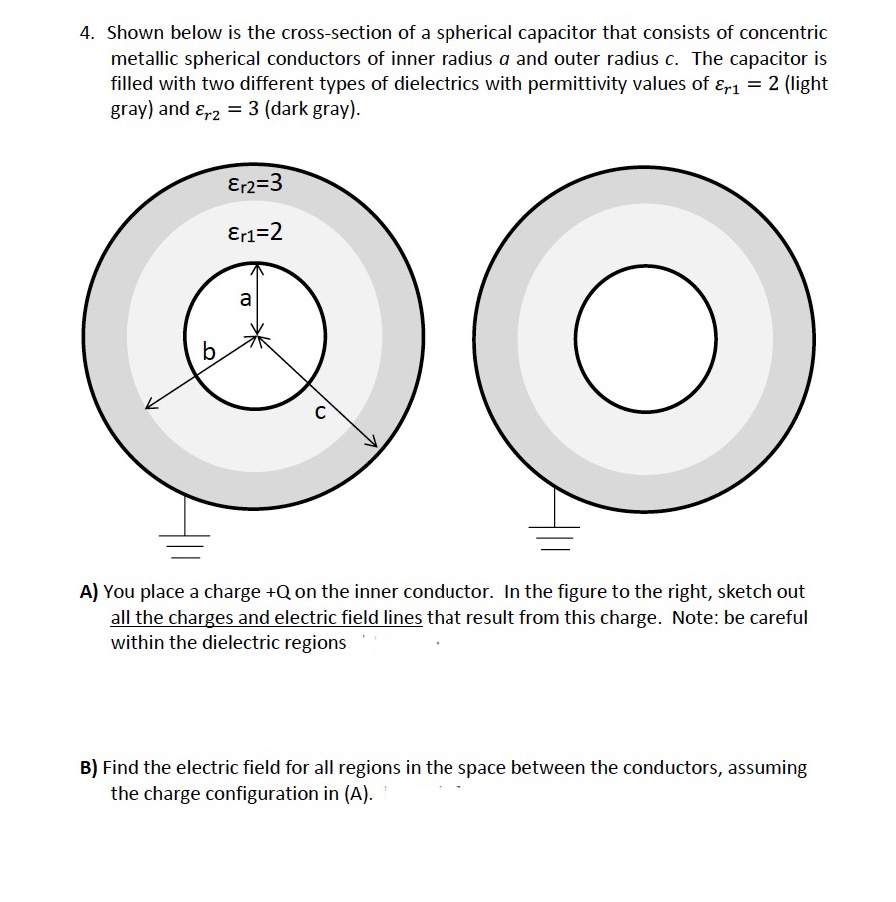4. Shown below is the cross-section of a spherical capacitor that consists of concentric metallic spherical conductors of inner radius a and outer radius c. The capacitor is filled with two different types of dielectrics with permittivity values of ɛr1 = 2 (light gray) and ɛ,2 = 3 (dark gray). Er2=3 Er1=2 b. A) You place a charge +Q on the inner conductor. In the figure to the right, sketch out all the charges and electric field lines that result from this charge. Note: be careful within the dielectric regions B) Find the electric field for all regions in the space between the conductors, assuming the charge configuration in (A).
4. Shown below is the cross-section of a spherical capacitor that consists of concentric metallic spherical conductors of inner radius a and outer radius c. The capacitor is filled with two different types of dielectrics with permittivity values of ɛr1 = 2 (light gray) and ɛ,2 = 3 (dark gray). Er2=3 Er1=2 b. A) You place a charge +Q on the inner conductor. In the figure to the right, sketch out all the charges and electric field lines that result from this charge. Note: be careful within the dielectric regions B) Find the electric field for all regions in the space between the conductors, assuming the charge configuration in (A).
Physics for Scientists and Engineers with Modern Physics
10th Edition
ISBN:9781337553292
Author:Raymond A. Serway, John W. Jewett
Publisher:Raymond A. Serway, John W. Jewett
Chapter25: Capacitance And Dielectrics
Section: Chapter Questions
Problem 49CP: A capacitor is constructed from two square, metallic plates of sides and separation d. Charges +Q...
Related questions
Question

Transcribed Image Text:4. Shown below is the cross-section of a spherical capacitor that consists of concentric
metallic spherical conductors of inner radius a and outer radius c. The capacitor is
filled with two different types of dielectrics with permittivity values of ɛr1 = 2 (light
gray) and ɛ,2 = 3 (dark gray).
Er2=3
Er1=2
b.
A) You place a charge +Q on the inner conductor. In the figure to the right, sketch out
all the charges and electric field lines that result from this charge. Note: be careful
within the dielectric regions
B) Find the electric field for all regions in the space between the conductors, assuming
the charge configuration in (A).
Expert Solution
This question has been solved!
Explore an expertly crafted, step-by-step solution for a thorough understanding of key concepts.
This is a popular solution!
Trending now
This is a popular solution!
Step by step
Solved in 4 steps with 4 images

Recommended textbooks for you

Physics for Scientists and Engineers with Modern …
Physics
ISBN:
9781337553292
Author:
Raymond A. Serway, John W. Jewett
Publisher:
Cengage Learning

Physics for Scientists and Engineers
Physics
ISBN:
9781337553278
Author:
Raymond A. Serway, John W. Jewett
Publisher:
Cengage Learning


Physics for Scientists and Engineers with Modern …
Physics
ISBN:
9781337553292
Author:
Raymond A. Serway, John W. Jewett
Publisher:
Cengage Learning

Physics for Scientists and Engineers
Physics
ISBN:
9781337553278
Author:
Raymond A. Serway, John W. Jewett
Publisher:
Cengage Learning


College Physics
Physics
ISBN:
9781305952300
Author:
Raymond A. Serway, Chris Vuille
Publisher:
Cengage Learning

College Physics
Physics
ISBN:
9781285737027
Author:
Raymond A. Serway, Chris Vuille
Publisher:
Cengage Learning

College Physics
Physics
ISBN:
9781938168000
Author:
Paul Peter Urone, Roger Hinrichs
Publisher:
OpenStax College